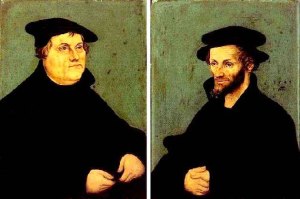A few months ago I wrote here about Melanchthon and his remarkable change of opinion with regard to the questions of contingency and determinism. It’s not entirely clear when he changed his mind, but the years 1527-1528 have been suggested. Recently I bought W.H. Neuser’s, Die Abendmahlslehre Melanchthons in ihrer geschichtlichen Entwicklung 1519-1530 (Neukirchen-Vluyn 1968). While reading some parts of it, I was struck by the fact that Neuser describes a parallel change of opinion, in this case with regard to eucharistic theology. In his book Neuser  elaborates on the eucharistic controversy between Luther and his followers on the one hand and Zwingli, Oeculampedius, but also ‘Schwärmer’ like Karlstadt on the other hand. Matters were, of course, far more complex than a division along one line of demarcation. While Luther tended to be blunt in eucharistic matters, Melanchthon striked a more nuanced note. Both men, however, were basically in agreement about Christ’s real presence.
elaborates on the eucharistic controversy between Luther and his followers on the one hand and Zwingli, Oeculampedius, but also ‘Schwärmer’ like Karlstadt on the other hand. Matters were, of course, far more complex than a division along one line of demarcation. While Luther tended to be blunt in eucharistic matters, Melanchthon striked a more nuanced note. Both men, however, were basically in agreement about Christ’s real presence.
In 1527 Melanchthon carried out, with three others, a visitation in Thüringen. There were considerable worries about this area, because of the obstruction against the Reformation in the monasteries on the one hand and of Karlstadt’s influence on the other hand. Melanchthon himself wrote the instruction for the visitation (July 1527). He locates the presence of Christ’s body and blood “in pane et in calice” (in the bread and in the cup). In the Articuli visitationis, the report Melanchthon made after the visitation, which was cut short on the 13th of August, he writes something different: “cum pane et cum calice” (with the bread and with the cup”). That’s more than a play upon words. It means that Melanchthon changed his mind with regard to the mode of Christ’s presence in the eucharist. A couple of questions arise from this observation of Neuser.
(1) What caused this change of mind of Melanchthon? Neuser suggests (p.276) – and I’m inclined to believe him – that the visitation confronted him with a massive heritage of roman catholicism, in particular the magic realism of the old opus operatum theology. In order to combat this, Melanchthon changed his own formulations with regard to the mode of Christ’s presence.
(2) Can we date the change more precisely? Yes, we can, to a certain extent. The terminus a quo must be the date already mentioned, when the visitation was terminated temporarily: August 13. The terminus ante quem is the 26/27th of September. At that time Melanchthon had a consultation with Luther about the visitation. We only know of the conversation between the two men from Melanchthon’s letters, but it is clear that Melanchthon felt uncertain about his eucharistic opinions. Initially, he was relieved about Luther’s reaction, but a month later his tone is bitter. “I don’t want to be involved with this question anymore”, he writes to Joachim Camerarius.
(3) Is there a link between his change of opinion with regard to the mode Christ’s presence in the eucharist and with regard to contingency and free will? That is of course a question that is not easy to answer. Both changes are dated in or close to 1527. That makes it worthwile to give the suggestion a serious look. To establish the connection precise textual research for the date of Melanchthon’s change with regard to contingency needs to be done. However, if – for the moment – we suppose that there is a connection, it seems plausible that the change of opinion has been initiated by the experiences of the visitation. Is that conceivable? Yes, I think so. It would for example mean that Melanchthon found out that the emphasis on God’s sovereignty made people indifferent. So, yes it is conceivable. But, is it probable? So far, I’m not convinced, although – I have to admit – I’m certainly intrigued by these two changes of opinion.

 Supper from John Calvin. He was only 27 years old at the moment he wrote this. It’s from the relative unknown Epistolae Duae, written in Basel, January 12th, 1537. You might recognize some of the important aspects of Calvin’s later teachings about the Lord’s Supper: the emphasis on the congregation’s participation, the proclamation of God’s promises as essential part of the liturgy, and indeed the symbolic signifance of bread and cup.
Supper from John Calvin. He was only 27 years old at the moment he wrote this. It’s from the relative unknown Epistolae Duae, written in Basel, January 12th, 1537. You might recognize some of the important aspects of Calvin’s later teachings about the Lord’s Supper: the emphasis on the congregation’s participation, the proclamation of God’s promises as essential part of the liturgy, and indeed the symbolic signifance of bread and cup.